Food security of the Russian Federation. Successes and failures. Part of 2. A lot of bread is good, a lot of meat is better
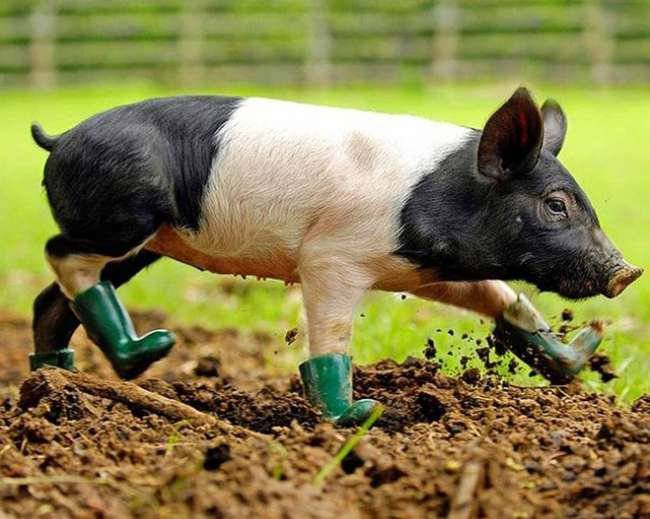
Above, I wrote about the summer rally of St. Petersburg oppositionists, who posted leaflets in the subway with clear propaganda against the “badist”. Sustained in the style of Soviet propaganda, these agitations made a stunning impression on the fragile minds of the liberal frantic youth. The post quickly went to the top LiveJournal and collected a few hundred enthusiastic comments (critical ones were not allowed - the freedom of speech is the same). The fragile minds for themselves learned the main meme: the last years, namely the 10-13 years, is an economic failure in all directions.
Regarding our topic today was this agitation.

Simply put, beef is bad. And again we recognize: this is true, albeit unpleasant. But, as usual, not all.
It is clear that the meat industry consists not only and not so much of beef: pork, poultry and lamb are also in our meat ration. And if not to tell the whole truth, it turns out that we are still selling oil, and with the money we buy we buy food (in fact, we are being pushed towards this conclusion). Or just change: we give them a barrel of fuel oil - they give us a dozen chops.
In fact, the picture is more optimistic. And in order to prove this, we will analyze the main branches "from" and "to". We look at such parameters as livestock, slaughter weight, productivity and so on.
To show the general situation in the sector, I offer you a chart of livestock products (cattle + poultry) over the past 13 years, the rightmost column (on all charts) will be responsible for the 1990 year, so to speak, for comparison between the RSFSR and the Russian Federation.
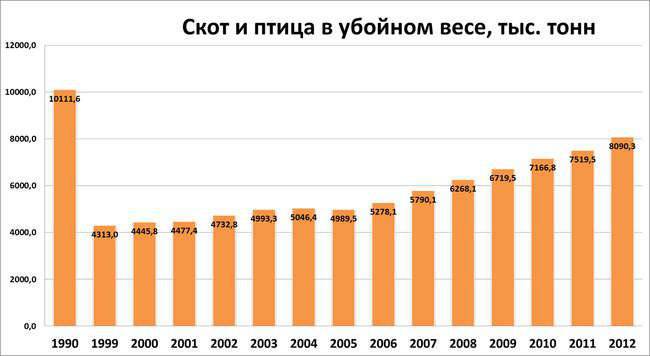
We see a catastrophic fall, starting with the collapse of the USSR and up to 1999, it was more than 2, after that we are seeing a dynamic growth, and as of 2012, the lagging behind the RSFSR is only 20%, whereas in 1999 it was 60%. Now we will consider the livestock industry in its main sectors: cattle, poultry, pork.
1) Let's start with the "painful topic" - beef. For a start, let's see how the cattle population has changed from 1999 to 2012.
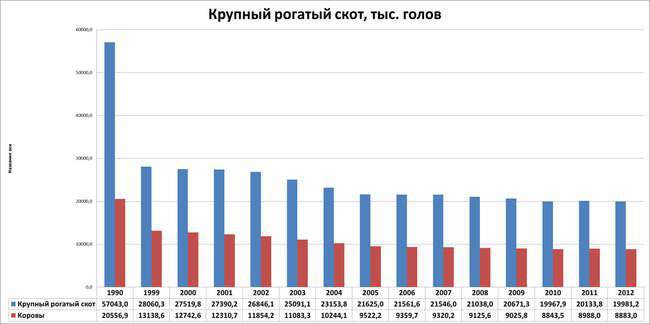
From 1990 to 1999, the livestock fell by half, then events developed with varying success, but the livestock went down, albeit not at a gallop, as in 90's.
Now let's look at such a parameter as the slaughter weight of cattle, in other words, the amount of meat (beef) that the country produced in different years.
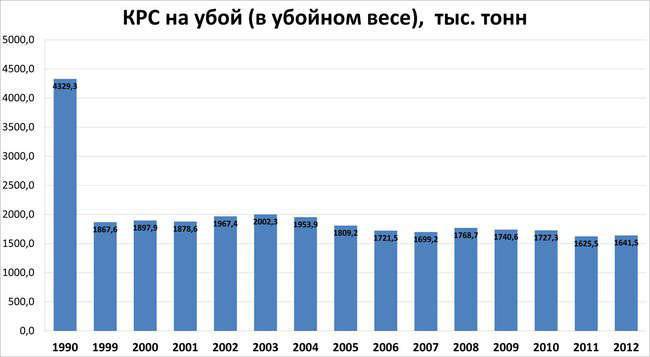
The picture in general corresponds to the previous schedule, however, the fall over 8 years after the collapse of the USSR was more than two times, in the subsequent 13 years there were no such failures, and the general trend is not clear, since the periods of growth of volumes are replaced by periods of recessions, though noncritical . By the way, in 2013, the figures went up again, as evidenced by decline in imports. It would not be superfluous to say that the population of the USSR was also experiencing problems with beef, and indeed with meat, about which there were even jokes.
But the production of cattle on meat does not end there, there are still dairy products. Let's look at the situation with milk.
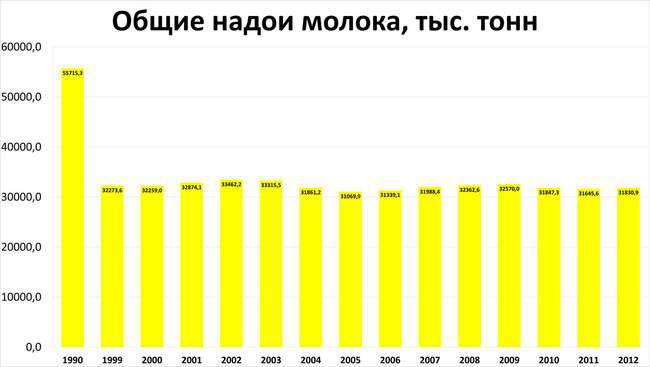
The picture is similar to the one that we have already seen above, but with the difference that milk production does not experience any special fluctuations, and the fall in the first 8 years of "sovereign" Russia was less than two times, namely 35-40% (let's remember this moment).
It would be wrong not to mention another such parameter as productivity, in our case, it is necessary with 1 cows per year.
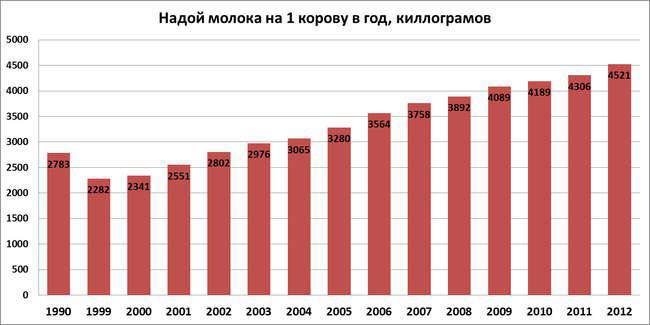
Here we see a much more positive picture, in 99-m the productivity of the "average" cows fell by 20%, but in subsequent years it did only that it grew and grew 1,6 times or 60%. Technology guys!
Now, in fact, we will try to at least a little to understand the reasons for this situation. I think the main reason is clear to all of us: due to the dire consequences of the collapse of the USSR and the succession of "imposed" reforms, the cattle livestock, and behind it the production of meat, swooped down at a very high speed. As a result, by 2000, the strongest collective farm or agricultural enterprise “survived”, in Darwinist it is called natural selection, and in the economy - capitalism. In relation to Russia, there were several other factors, a little less significant or purely “national”. As the saying goes, “to break - not to build” or “what we have, do not store, if we lose - we cry”, in our situation these phrases are just as useful as the livestock that has been growing over the years has been lost in some 8 years, In the following years, the state had a lot more serious problems, and purposefully the issue began to be solved only 5 years ago. As for the situation with milk, the conclusion can be made on the basis of the following data.
The number of cows (namely, cows) in 1999 decreased by 1,5 times, in the same period, milk production decreased by the same 1,5 times, but by 2012, the number of cows decreased already 2,3 times in relation to 1990 and 1,5 times in relation to 1999, however, the reductions were reduced only 1,75 times (to 1990) and did not change in relation to 1999.
From all this, we can conclude that with the dairy industry, things are, in principle, very good, and the recipe for "complete recovery" is quite trivial: to increase the livestock and productivity of "one head", however, in practice it does not look like that .
The problems of beef production (and milk, respectively) are rooted in the fact that the sector simply shows negative development indicators. In other words, with the 2000 year, with varying success, the livestock of animals is either decreasing or growing, and the situation with production volumes is about the same. This is primarily due to the culture of consumption of this meat, as well as to the low investment attractiveness - because it is more difficult to raise a cow than the same pig or chicken. Equally negatively affect private investment and long payback periods of projects, price fluctuations, unpredictable weather, etc., which is typical of our natural area.
Moreover, in the production of beef in slaughter weight, 90% is still accounted for dairy breeds. For comparison: in European countries, the share of beef cattle accounts for 40-50% livestock, and, for example, in Brazil - 95%. That is, beef production in our country is still a kind of secondary process in the production of milk. In the first place among the breeds of "beef" cattle should be put Aberdeen-Angus breed: it has high adaptive and productive properties. Aberdeen-Angus became the number one breed in beef cattle breeding in the USA, Canada, Australia, New Zealand and a number of other countries. For example, in the USA over the past 10 years, the proportion of the Angus population has increased from 60 to 70% and continues to grow. With intensive cultivation and fattening, bulls reach a live weight of 600 kg at the age of 15-16 months with average daily gains over the whole cycle more than 1 kg (!!!), and the slaughter yield is 60%. Moreover, carcasses correspond to the highest quality categories according to Russian and international standards. In Russia, the Aberdeen-Anguses of a modern large type have proven themselves in terms of the application of innovative technologies and with year-round housing maintenance in Kaluga, Voronezh, Bryansk, Lipetsk, and a number of other areas. Under these conditions, livestock safety is at least 98%.
Now I have a question for specialists: how much time is needed to double the livestock of a certain breed? It should not be forgotten that part of the grown gobies must go under the knife, since any agricultural enterprise needs money. It has been said above that in ten years the proportion of Angus in the livestock has increased by 10%, that is, by 1% per year. Affects me, this process will have to take more than one "five-year" period. As far as I know from my rural childhood, a cow’s “pregnancy” lasts from 7 to 9 months.
But the state is ready to support effective producers. In particular, subsidies are provided for the purchase of pedigree cattle; refundable interest rate on loans. Moreover, for meat cattle from the federal budget 100% of the Central Bank refinancing rate is compensated. In addition, when insuring farm animals to a producer at the expense of the federal and regional budgets, 50% of the insurance cost is compensated. Support is also being provided in the framework of co-financing of economically significant regional programs for the development of beef cattle breeding. These are all positive signals for the market.
However, it should be recalled that in recent years a whole series of large projects in the field of industrial beef production was announced. Especially here we should highlight the Bryansk project Miratorg, which, by estimation, will be able to cover the country's demand for this kind of meat with 10%. It is expected that with the commissioning of these projects, the production indicators in the segment will begin to grow again. Moreover, the import of pedigree livestock in the Russian Federation is growing from year to year, as evidenced by new enterprises and farms, for example:
Miratorg Agro-Industrial Holding Completes Acceptance of 7 900 Heads of Aberdeen-Angus Breeding Cattle from Australia (The number of breeding cattle on the Miratorg farms in the Bryansk region on 2 in November 2012 exceeded sixty thousand heads.)
The first batch of breeding cattle in 2013 was delivered to Russia (2 293 heads of highly productive cattle)
"4200 frost-resistant cows from the USA sailed to the Kaliningrad region"
Miratorg Agribusiness Holding delivered the largest batch of Aberdeen-Anguses to the Bryansk region - 13 thousand heads
Over 18 of thousands of cattle arrived in Russia from Australia
Bryansk region: Miratorg built a cattle farm on 4000 headsby increasing the number of sites to 27
Montbeliard arrived in Voronezh region
Record number of livestock sent Altai breeders to the Republic of Sakha
ABH Miratorg delivered to the Bryansk region another batch of cattle from the USA (the next, already the sixteenth in a row, a batch of animals of the breed Aberdeen-Angus. The total number of the arrived breeding livestock was 4 049 heads.)
Two-fold increase in the number of pedigree cattle in the Bryansk region (throughout 2012, 43 764 heads of breeding cattle were received by Bryansk farms, which is twice as many as in 2011)
In the Novgorod region a large agricultural enterprise for beef cattle breeding is being created.. (The essence of the project: the creation of a breeding reproducer for breeding cattle of Aberdeen-Angus breed with its own broodstock 4000 heads, a specialized fattening complex with a capacity of more than 6000 heads, production and sale of beef meat products. Project implementation period: 2012-2019 years).
The list is far from complete, you can independently walk on the Internet in search of this information. But when analyzing the number of imported heads, keep in mind that one such bull stands like a used car, about 3,5 thousand dollars.
In general, today several projects are being implemented in beef cattle with a total investment of over 35 billion rubles. But so far this is not enough for our country. A noticeable player in the Russian beef market - with an adequate level of investment - we can become in the next 5-7 years.
According to the forecasts of the Ministry of Agriculture of Russia, the state support of the development of cattle will allow to double the livestock in the country by 2020. Consistent government policy in this area will not only create efficient industrial production of beef and meat breeds and provide consumers with high-quality, environmentally friendly meat produced in Russia, but also solve many social problems of the village, including the general increase in living standards in rural areas.
As a result, the future of Russian cattle breeding inspires cautious optimism and does not at all incline to panic moods, as the participants of the action “Kind Car of Half-Truth” wanted.
2) Now let's move on to another area of animal husbandry - piglets.
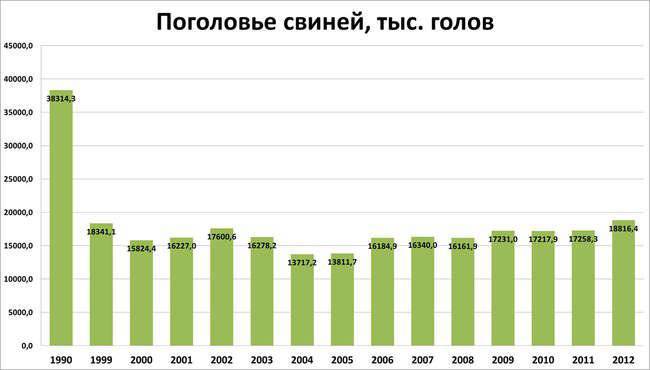
As you can see, the "traditional" double fall in livestock in 1999 and slow, but stable growth since 2005 year, which is good news.
Now look at the proportion of products.
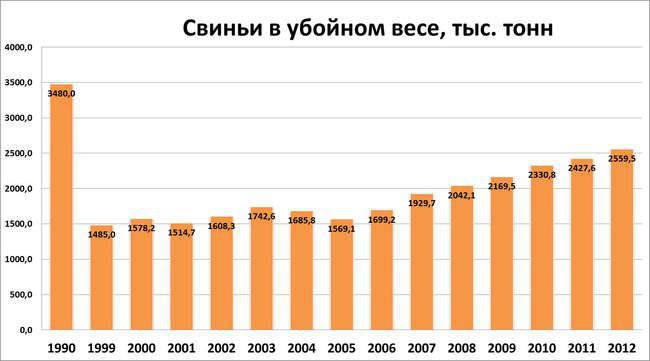
In general, for the pork, I am personally calm. Judging by the pace of recent times, Gorbachev’s time will soon be catching up: in two or three years. Have you noticed that livestock growth and production growth are disproportionate? This once again suggests that our agriculture has gradually overcomes the difficult path from the “traditionally Soviet” approach to the modern - high-tech one.
3) Next in line is the situation with poultry meat. Let's start, as always, with livestock.
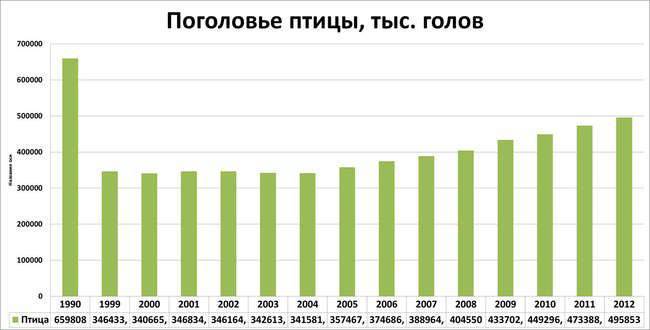
Here with the bird - all the wonder and wonder. There, most likely, there was some more political background, such as the task was set to get rid of dependence on the American “Bush legs”. Well, and normal. But our poultry farmers directly bloomed.
And what about the chicken? And that's what.
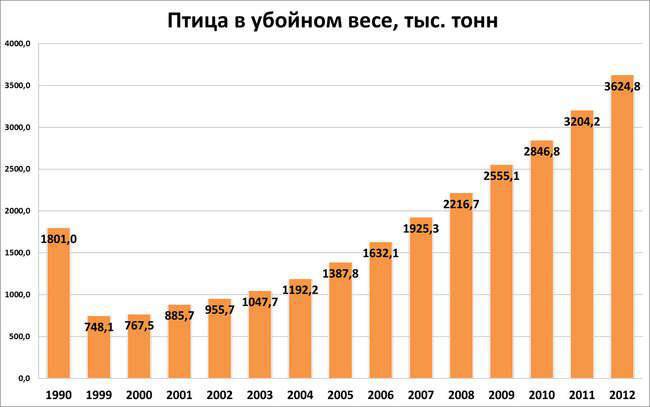
As they say, comments are superfluous. In the 2012 year, we were twice ahead of the indicators of the RSFSR and almost 5 times (!!!) indicators of the 1999 year! Cheers, comrades, cheers !!! Now, we can say with confidence that the indicators of the RSFSR on the bird breathe to us in the navel, and the performance of 90-x - in the knee. The fall from 1990 to 1999 was 2,5 times.
True, we have forgotten another poultry product - eggs. What do we have there?
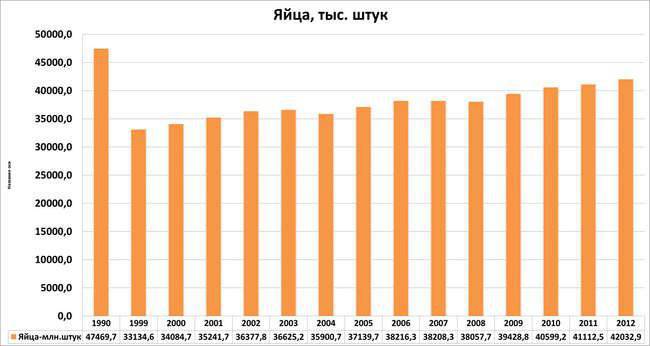
There is an obvious orientation of our poultry industry to its meat component, although the number of eggs has been growing steadily for several years now, and it is quite possible that the RSFSR will bypass 2-3 of the year. Growth relative to 1999 was 27%, however, it is now clear that only the “non-meat” part of the poultry industry survived by 1999 (the drop in livestock was 2,5 times, and the drop in the number of eggs was 1,5), and with 1999 we restored the meat poultry industry with almost zero
On this, in principle, and all. For general information, I just have to give figures on secondary industries, such as, for example, honey.
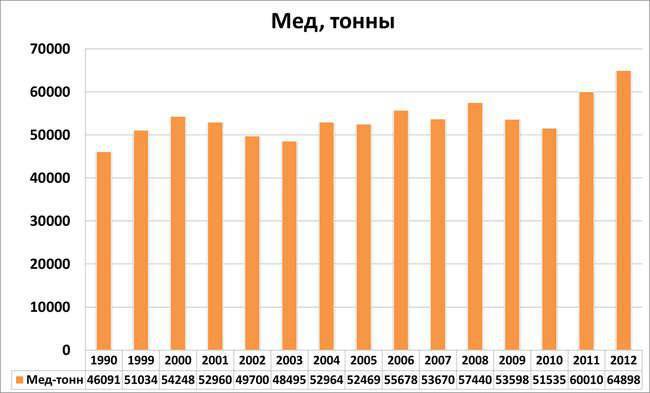
Or reindeer herd.
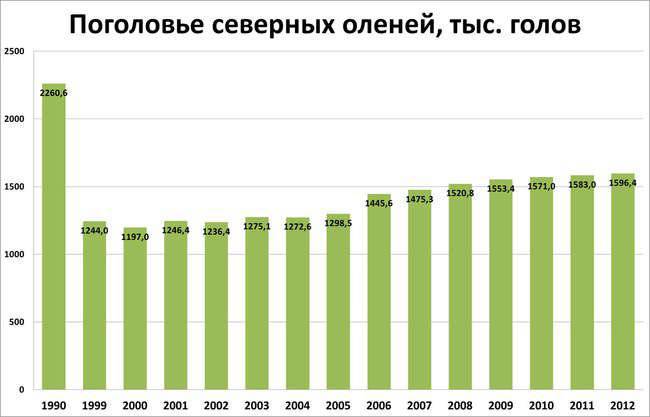
Conclusions.
1) The main problem of cattle breeding in the Russian Federation is cattle, namely its “meat” part, this is largely due to the fact that 90% of cattle for slaughter are dairy breeds.
2) Currently, cattle livestock production is focused on dairy products, but in recent years the center has begun to mix. The reason for this is the active purchase of pedigree "meat" cattle abroad and, as a result, attempts to increase its population in the territory of the Russian Federation.
3) Losing the number of cattle is a hundred times easier than increasing it, because increasing the number of cattle is a long and complicated process, which is influenced by many factors, and it can take several five-year plans.
4) Dairy production in the Russian Federation shows even small but stable growth in such an indicator as total milk yield and excellent performance dynamics (milk yield per cow).
5) Pig breeding demonstrates stable and dynamic growth in both livestock and meat products.
6) The poultry industry is the main driver of the Russian meat industry, the 1999 indicators of the year (five times) and twice the indicators of the RSFSR.
7) Egg production in the Russian Federation is growing every year, but it is inferior to the rate of "meat" poultry farming, which indicates that the sector is focused on meat production, though not as much as with cattle.
In the last, third part of the article we will talk directly about the situation with food security of the Russian Federation.
PS Since this article is only the second part of three of one big work, I ask you, dear readers, to rate the article, and all yours constructive remarks and constructive critic to place in the comments to the last (third) parts. Thank.
- Sledgehammer102
- Food security of the Russian Federation. Successes and failures. Part of 1. Battle of the harvest
Food security of the Russian Federation. Successes and failures. Part of 2. A lot of bread is good, a lot of meat is better
Food security of the Russian Federation. Successes and failures. Part of 3. Dry residue
Information